 If you asked 50 people how to build backlinks and gain rank, you would undoubtedly get 50 different responses (probably closer to 100 because no one I know can ever stop at just one method ), and herein lies the problem.
If you asked 50 people how to build backlinks and gain rank, you would undoubtedly get 50 different responses (probably closer to 100 because no one I know can ever stop at just one method ), and herein lies the problem.
Building backlinks and trying to rank in Google is like an enigma wrapped in a riddle.
What works one day does not necessarily work the next, and more importantly – what works for one niche will definitely not apply to other niches.
Go figure, right?!
But that’s the nature of the beast – and even Matt Cutts himself will happily admit that there is no ‘one rule’ that will work when it comes to SEO.
So what do you do?
Reverse Engineering is the answer to this conundrum because it goes well beyond the concept of ‘finding good places to get backlinks from‘ and takes your high search engine ranking optimization to an entirely new level.
But What IS Reverse Engineering?
Reverse engineering refers to the process of using various online tools and services to spy on and track your SEO competition, to find out exactly where they are getting their backlinks from – and to find the pattern (if any) that exists within this specific SEO profile.
Why is Reverse Engineering so Powerful?
As I mentioned earlier, Google is an enigma (wrapped in a riddle) and figuring out how Google works and what it deems as ‘valuable’ and ‘relevant’ is like trying to play darts blindfolded – it really is that hit and miss!
But when you apply reverse engineering, you completely remove ALL of the guesswork associated with this aspect of link building.
By analysing the backlinks of our competitor we are not only learning where those backlinks are coming from, we are learning which ones Google is lending the most weight to – and THAT is worth its weight in gold!
But enough about the why.
Let’s take a real life example and show you exactly HOW to go about reverse engineering our competition, and WHAT we are looking for when we go about this process.
*I do SEO for a living, and the processes I am going to go through today are the exact processes I use when clients pay me big money to outrank their competition – and I can safely assume that these are the same tactics employed by the majority of SEO firms around the globe.
How to Reverse Engineer your SEO Competition
There are dozens of online tools and services that can provide you with the relevant data to go about reverse engineering your competition.
For the sake of simplicity (and to stop your frontal lobe from leaking out of your nose mid article), I will only be using 2 services, 2 of the best in my opinion – and although both these services cost around $99 a month – the information provided with your ‘free account’ is more than adequate to start learning this process.
Although I have a paid subscription to both services I am using today, I will NOT be logging in and using it because I wanted to show you how powerful this method is using only the free option – AND I wanted you to be able to go and try it for yourself without anguising over whether it was worth the money or not.
The services I will be using are:
- Ahrefs.com
- OpenSiteExplorer.org
*Ahrefs is $79 a month where as OpenSiteExplorer is $99 a month.
Ahrefs is (in my opinion) a far better service, with a much more user friendly interface; the fact that it’s $20 cheaper just makes the decision a no-brainer.
The example I will be using today comes from an offline friend who owns a Printing Shop in Romford, near Essex in England and is having trouble stealing that no. 1 spot in Google from another local printing shop located just down the road.
Disclaimer:
Although the example provided is an offline business relying on a specific geographical (location) keyword -Romford- the information and processes I go through can be applied to ANY online or offline business in every niche imaginable.
The Scenario as it Currently Stands
“I need some advice – when searching “The Print Centre Romford” We are #2 in the search results ….. I believe I’ve done everything in my power to make us #1, but for some reason I can’t get that coveted #1 spot (it’s currently held by a customer of ours who has some office space here) – I’ve google verified the address, website and email – but I REALLY need to know how to get that spot ….”
Let’s begin by taking that URL at #1 and entering it into Ahrefs.com…
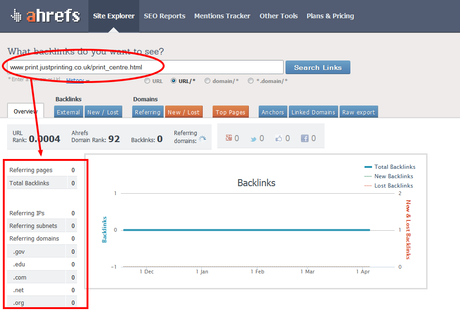
Straight away we have established that the actual page ranking is only holding that top spot because of two factors:
- The main site is providing all the SEO and backlink juice to support this one page;
- This one page is ranking simply because the keyword ‘Print Centre’ is the actual page name.
So we need to investigate that main page and find out exactly where that ‘juice’ is coming from…
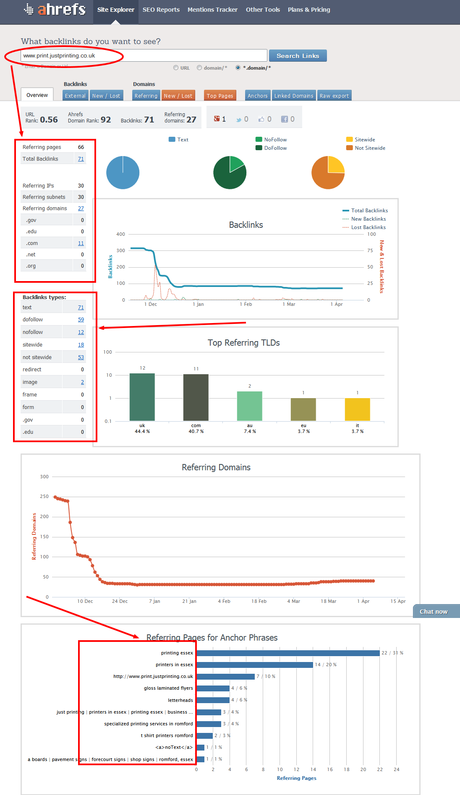
So what exactly are we looking at here?
The information provided is broken up into sections, each one detailing the various aspects of the sites SEO profile, from the number and type of backlinks, to the anchor text used when linking, and even the attributes of each link (dofollow, nofollow, etc).
For now we will only be focusing on the actual backlinks themselves, but there is something interesting about the anchor text that deserves mentioning first.
Our goal with this exercise is to outrank that site/page for the keyphrase ‘Print Centre Romford‘ and the fact that less than 9% of the anchor text profile contains this word means that this should not be too hard.
It seems this site is more interested in ranking for Printing Essex than it is in ranking for Romford – and although the two places are geographically neighbors, the fact remains that stealing their top spot for the Romford part of the equation will not be too big a task.
If our goal had been to rank for Print Centre Essex, then this task would become a lot more difficult. (These are the sorts of factors you should be thinking about and taking into consideration when reverse engineering your competition).
For now, we have garnered enough information from the anchor text, so it is time to delve deeper into their one way link building profile…
Breaking down the Backlink Profile
The above screenshot shows that our competition has a total of 71 backlinks coming from 66 different pages.
Luckily for us none of these are .edu or .gov backlinks (.edu and .gov links hold more weight with Google because (generally) you cannot buy links from these TLDs (Top Level Domains) and the overall consensus is that a link from here is a genuine sign of value and relevance.)
Let’s click on the ’27′ next to Referring Domains and see what we can see.
Keep in mind that the free service will only provide you with the top 5 or so backlinks. (If I were to log in, I would see the results for every single backlink that existed.)
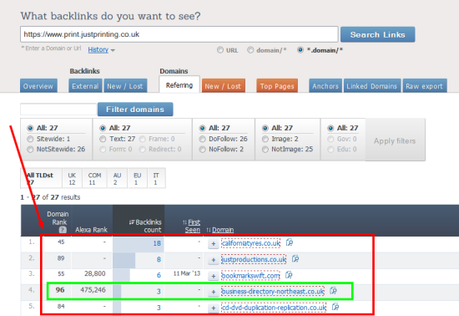
A quick glance at their backlinking profile tells me a number of things:
- Out of the 27 referring domains (external backlinks), only 1 is sitewide and the rest all point directly to this actual homepage (not good for them, but good for us. Since the Penguin update, the importance of sitewide links has increased dramatically – meaning you should be sending back links to deep nested pages on your site as often as you send them to the homepage).
- Out of the 27 referring domains, only 1 is a no-follow. With only 27 links in total, this is not something that will have a negative impact on their SEO profile, but if they continue on this trend then they will be punished for it. (Again, since the Penguin update the onus on natural link building has become paramount, and a site that contains only dofollow backlinks does not look natural at all.)
Now that we have established the overall profile, it’s time to take a closer look at the backlinks themselves.
But what exactly are we looking for?
There are 2 main pieces of information we should be paying attention to here:
- The Domain Rank or Domain Authority
- The page that backlink is coming from
I have highlighted in green the one backlink that really stands out because not only does it have a really good domain rank, it also seems to be a business directory listing site – meaning there’s a really good chance we can grab a backlink from them too.
Let’s find out…
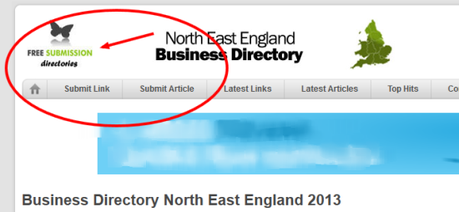
Yep.
So with hardly any effort we have already managed to find a highly relevant site with really good domain authority that, more importantly, we know Google places a lot of value in.
NEXT:
The link above this one also looks like a boomarking directory site, and although the domain rank is a lot lower, the Alexa rank indicates that there is good search engine traffic (and we already know Google values it!).
Can we possibly get a backlink from here too? …
 Two from two!…
Two from two!…
NEXT:
Let’s now take a look at the results that OpenSiteExplorer.org gives us and see if there are any more SEO benefit we can garner from this process.
*Remember that we are using the free version of these tools so the details provided are pathetic at best – and still we have managed to secure 2 excellent backlinks from it. 
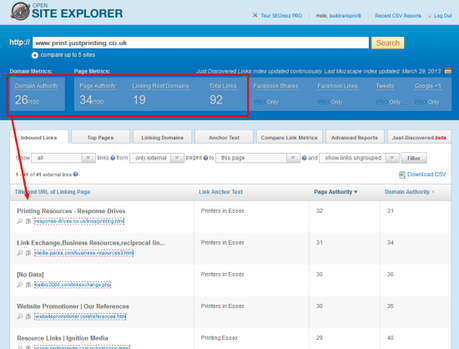
Although the details provided are slightly different, the overall SEO profile can still be seen here.
Again the anchor text of Essex Printers seems to be their main focus – meaning our drive to rank for Romford should be a little easier.
OpenSiteExplorer gives us the backlinks in order of Page and Domain authority, from highest to lowest (again only a handful of the total links are provided so there could be more authority links hidden from our view – but really, we have enough here to continue working our magic).
The backlink that really stands out here is the first one in the list because it has the highest authority of all the listed links AND it comes from a directory listing type site…
Let’s check it out:
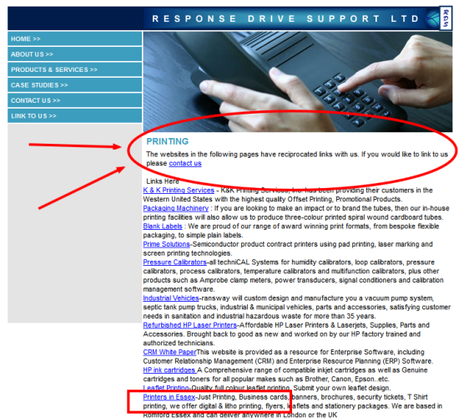
More success!
Not only can we get a backlink from this site, we can see the backlink that our competition has. (highly relevant category/page too!)
Page 2 of the OpenSiteExplorer backlink results gives us even more information to work with:
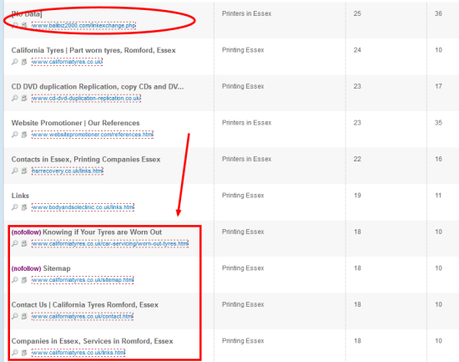
A further breakdown of these links (highlighted) reveals that not only can we get a link for ourselves from the first one, but half their backlinks listed here seem to be coming from the same website!
This instantly tells me two things:
- They obviously have another site that they administrate and have taken the liberty of adding their link to the sidebar or footer, so it appears sitewide;
- The same website means the same IP address – and since the range of IPs that form your backlinking profile is such an important factor to Google – these guys are not as strong a force as I first imagined. Sweet!
- They seem incredibly obsessed with the keyword Printing Essex – to the point that I wonder if they’ll get slapped?
A quick search of the aforementioned backlinks reveals the following:
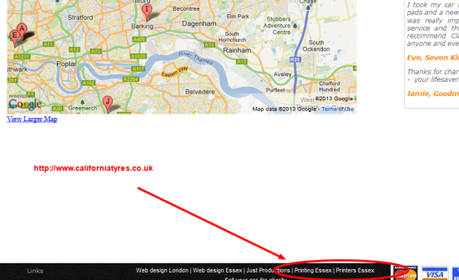
And there it is – a link in the footer of a site they obviously own or administer.
In fact, there are two of them. (now THAT is just plain stupid, especially considering the keywords are almost identical)
Reverse Engineering Marketing Takeaway
Building backlinks and ranking your site in Google has always been a case of trial and error – of testing and retesting.
However, there are some aspects of the SEO game that just work.
This is one of them.
Granted you still need to create good content and share this content across as big an IP range as you can, but with reverse engineering you can quickly establish not only where to get the backlinks from, but the sort of backlinks that Google is obviously happy with and wants to see more of.
Something else you can do is to reverse engineer some of the bigger sites in the more competitive niches – even if you are not in that particular niche!
The reason I suggest this is because these larger sites with a lot of competition have to work ten times harder to get the same results in the SERPs.
What this means for you is a broader range of possible backlink targets, and more often than not – a few Web2.0 sites that you may have never heard of…. (meaning your primary keyword will probably still be available when you attempt to register MyAwesomeKeyword.Web2.0.com 
Alex Whalley
Alex Whalley is a full-time blogger and affiliate marketer who is not very good at writing effective bios. Alex blogs over at Build.Rank.Profit – the niche site marketing blog and has just launched a new SEO service that offers free SEO site analysis. Follow the link or visit www.Rankonomics.com to see how your site stacks up.

